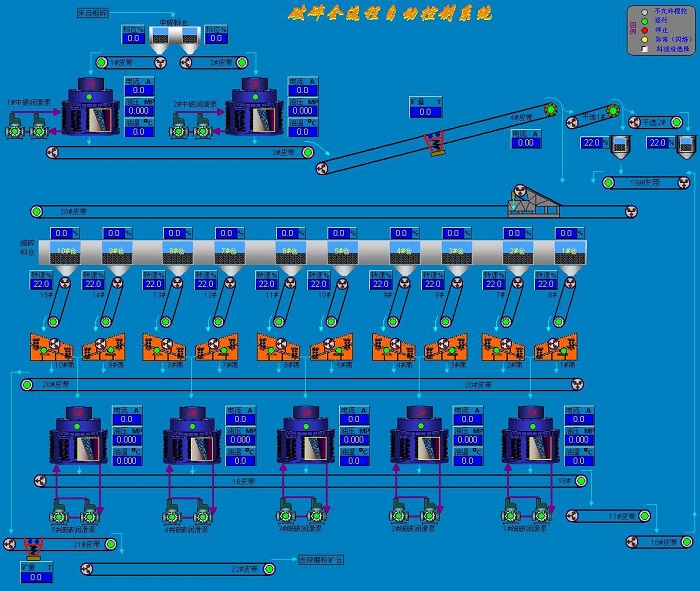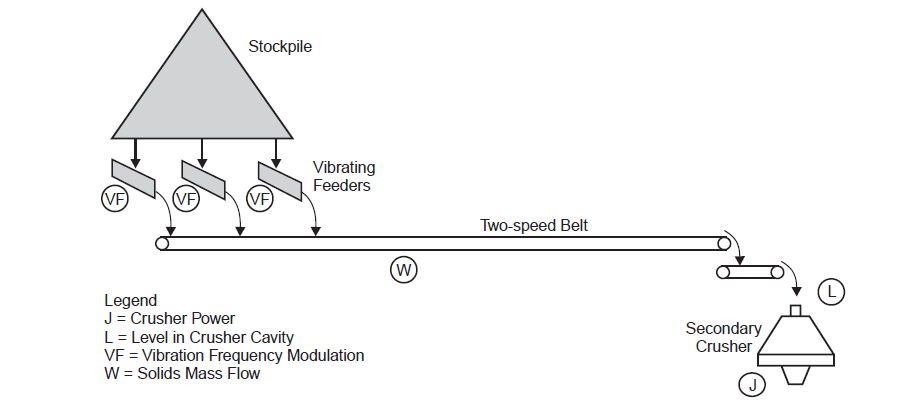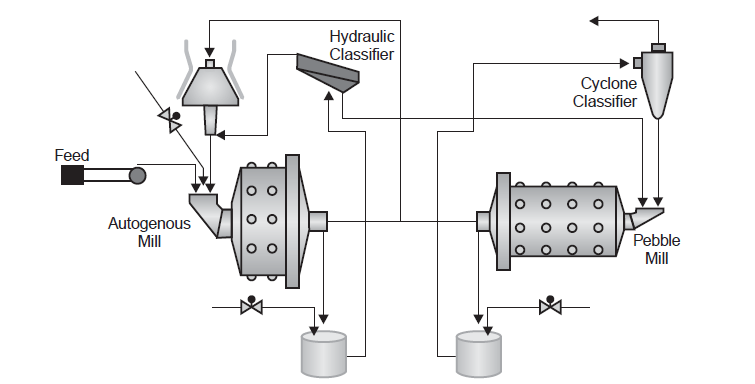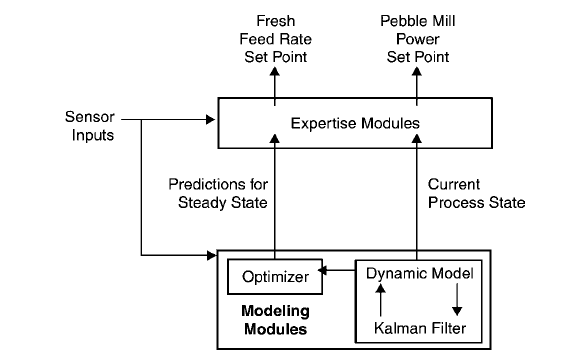To conclude the discussion on mineral processing plant control, two case studies are presented. One is taken from crushing and the other from grinding.
Crushing Case Study
In the new millennium crusher control applications in mineral processing will be largely restricted to primary and autogenous/semiautogenous pebble crusher applications. Nevertheless, there are still some crushing plants in operation, and from a pedagogical perspective, some interesting lessons can be learned from the control work that was performed in these types of operations.

Figure1 provides the process and instrumentation layout required for the example. Because the secondary crushing circuit was proving to be a bottleneck for overall plant production, the general objective was to increase throughput.

Fig1. Secondary crusher control process and instrumentation layout
A number of control problems in this circuit rendered more traditional methods ineffective, including the following:
_ Given the scale of the equipment, there was a significant dead time between the weigh scale and the vibrating feeders, and between the weigh scale and the symons cone crusher.
_ Stockpile segregation meant varying particle size distributions from each feeder; i.e., the tonnage
corresponding to maximum throughput or maximum power varied depending on the feeder configuration in use.
_ Vibrating feeders were prone to both hang-ups and sloughs of material onto the belt conveyor.
To tackle these problems, the control engineers began by employing a regulatory loop to control solids mass flow by manipulating the vibration frequency of the feeders. Because PID was ineffective, a dead-time compensation scheme (Dahlin algorithm) was employed to improve the control performance. In addition, and because the number and specific configuration of the feeders could be changed, the regulatory control algorithm also included scheduling for process gain (i.e., based on the number of feeders running) and the estimated dead time (i.e., based on the specific configuration of feeders running). This proved to be a very effective approach to achieve good regulatory behavior, and it is of some interest to see that similar techniques are now used on large semiautogenous mill feed systems, which suffer the same control problems.
Having solved the regulatory problem, the supervisory strategy was to ensure maximum throughput. Because this crusher treated a scalped primary crusher discharge (-200 mm × 19 mm), level control in the cavity is not generally a suitable means of control, because coarse hard feed will lead to a plugged crusher. (However, level is monitored to prevent spillage and to aid in control when the ore is fine, soft, or both.) In this particular instance, maximum throughput generally relates to maximum power draw.
Given the variability in size and ore hardness, it is intuitive that the relationship between power and tonnage is nonlinear. Approaches ranging from fuzzy expert control to self-tuning controllers have been applied to this nonlinear problem, but the control engineers in this instance elected to use a clever implementation of Model-Reference Adaptive Control (MRAC).
To complete the MRAC installation, the engineers chose to remove tonnage from the regulatory loop and substitute power. In other words, tonnage was used only for power prediction purposes, and the dead-time compensation controller was effectively regulating power.
Previously, it was indicated that vibrating feeders are prone to sloughing. A large pile of rock on the belt would cause the controller to make a quick reduction in feeder speed, but it would soon return to near normal, once the pile passes the weigh scale. However, this large pile of rock may well be sufficient to plug the crusher. The operator, who would be responsible for cleanup, would soon switch the power controller into manual mode, citing excessive downtime, for example. To circumvent this eventuality, a watchdog function monitors the weight profile on the belt, and when a large pile is discovered, it will suspend the supervisory controls, slow the feeders, decrease the belt speed, and hold this condition until the pile of material is known to have passed through the crusher, whereupon normal control is restarted. There are numerous other examples of watchdog control in this specific case, and their existence is one of the principal drivers behind the embrace of fuzzy expert systems as the platform of choice for supervisory level automation in mineral processing.
Grinding Case Study.
With their relatively high capital and operating cost, grinding circuits have been the focus of much of the attention in industrial process control for the past four decades. There are other contributing factors, such as the fact that these circuits are fairly well understood from a phenomenological point of view, and that in many plants grinding turns out to be the bottleneck in economic optimization. This latter point often leads to maximum-throughput strategies, which have the additional complication of accommodating the physical capacity constraints of the equipment.
Figure 2 is a simplified iron ore processing or lead-zinc ore mining representation of the flowsheet for the case study. The control objective is to maximize throughput while maintaining a product particle size dictated by downstream production processes.

Fig2. Flowsheet for autogenous and pebble mill circuit

Fig3. Software structure of the MBEC system
This particular circuit was well instrumented and had very good regulatory controls and welltrained operators using modern control hardware with an excellent HMI. Nevertheless, frequent changes in ore hardness tended to lead to conservative operation to avoid overloads. More specifically, in soft ore that is lean in coarse-grinding media, the autogenous mill operates with low power draw and a high circulating load of pebbles. The manual supervisory strategy was to set the fresh feed rate and to change it only when the pebble recycle stream reached high or low values. In cases where the ore was hard, the autogenous mill tended to run at high loads and high power draws, with low pebble recycle. Once again, the manual supervisory strategy was to run at a conservative feed rate to avoid overloading the autogenous mill (i.e., high charge levels). In both cases, it was difficult to maintain product particle size, and opportunities to increase the feed rate were often missed.
In this case a Model-Based Expert Control (MBEC) supervisory strategy was implemented. The basic structure for such an algorithm is shown in Figure3. It consists of the heuristics encoded in the expertise modules, as well as deep process knowledge, encoded in the phenomenological mathematical models.
This structure utilizes the models to estimate the state of the process, including the prediction of many variables that would otherwise not be measurable (i.e., a soft sensor). Because there are temporal changes in the feed and equipment characteristics, the model is adapted to ensure a minimum of plant-model mismatch. Both of these functions are accomplished by embedding the model in an extended Kalman Filter. One of the outputs of this modeling module is the current process state, which can be used directly by the expertise modules. The other is a welltuned dynamic model, which can be used with the process state information in the optimization modeling module. In this case, the optimizer simply integrates the model to predict the steady-state results if no disturbances were to enter the system, under any particular combination of regulatory loop set points. The results of these steady-state predictions can then be used to recommend regulatory loop set points that will achieve optimal grinding performance.
Because the grinding circuit cannot be perfectly modeled, and because there is a need for watchdog functionality, the expert modules play an important role in the supervisory control strategy. A particularly important aspect is to filter the set points coming from the optimizer, because these are based exclusively on model calculations, which in turn can be sensitive to sensor problems in the field signals.
Extensive on-off testing of the MBEC supervisory strategy against the manual model of operation demonstrated a 6% improvement in grinding circuit throughput and a much lower variance on product particle size distribution. The economic impact was not disclosed, although the payback period was said to be a few months.
To conclude, it is worth noting that the approach taken in this latter case study is rapidly becoming the industry standard. The use of process models is highly recommended, and despite any intuitive belief to the contrary. For supervisory control in beneficiation plant, best practices mean a mix of expert systems and mathematical models. The exclusive use of one or the other will likely lead to suboptimal results.